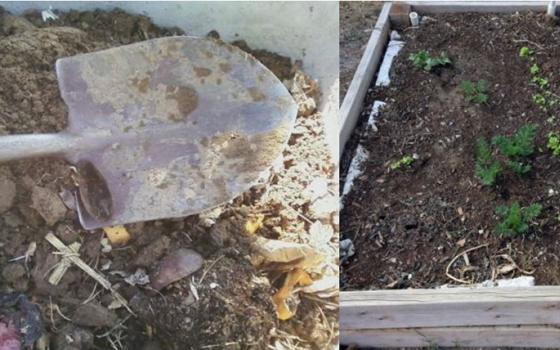I think nothing shows forth the Paschal Mystery quite like compost. It has been part of my Lenten observance this year, though it started the last weekend of January, several weeks before Ash Wednesday. While much of the rest of the country was buried by blizzard after blizzard, the sunny mild winter of the desert Southwest drew me outdoors. Raised garden beds were still offering us salad greens and even a few radishes. Looming in the background, however, was the compost bin that had suffered neglect since midsummer.
We are not purists in the care and feeding of our compost bin. While we observe the general principles regarding the kinds of kitchen refuse that can be composted, we are not diligent about layering levels of “organic matter”(i.e. manure), keeping the pile moist and regularly aerating the contents of the bin. For many months we had just emptied our little kitchen bucket into the bin and closed the lid. I knew it was almost full and thought it could possibly be just a huge pile of half-rotten garbage. On a fine Saturday morning with no excuses, I decided to get to the task.
Years ago a friend gifted us with a black pull-apart composter when they discovered the creepy crawling workforce that is an essential ingredient of the process. The bin has a nice lid, several air vents and two handy little trapdoors at the base that make it convenient to remove the magic soil that is the final product. In my experience it has never been that easy. I’ve learned to unlatch sides of the bin, carefully remove and reassemble them at the site of the next compost pile, and then stand clear for the inevitable frantic rush of insects in search of cover. This can be especially disgusting in the heat of the summer. Once I even uncovered a nest of field mice – a particularly sad experience!
As I removed the sides of the bin I was making plans to shovel the entire contents into garbage bags for disposal. When I realized that there weren’t too many cockroaches fleeing the scene and that they were moving more slowly in the cool morning, I decided to take a little sample from the bottom of the pile. I used a hand trowel to gingerly dig a few inches below the surface and was surprised to find a quantity of compacted rich brown soil. With renewed enthusiasm I made a quick trip to the neighbor’s horse pens for manure. When I returned I shoveled the un-composted material from the top of the pile into the new bin along with the manure and dry leaves from the yard.
What remained was a cylinder, almost 20 inches high, of compacted compost. I got my garden gloves, a trowel and a container and sat cross-legged on the ground in front of it and I began to dig. There was much sifting and sorting to the work. I found small pebbles, rubber bands and wire ties that had bound celery and lettuce, plastic stickers that had marked fruits and vegetables, pits of avocados and peaches that had not fully decomposed. There were bugs and slugs-o-plenty, and I tried to send them scurrying in the direction of the newly established bin. I discovered the source of the melons and squash that volunteer in our garden each summer. Those seeds apparently don’t compost well, and the plants always seem to be God’s way of showing off because they do so much better than those I’ve carefully tended!
The soil that passed through my fingers was a review of the past many months and meals in our community: the peach harvest in July, the green chile roast of autumn, the Thanksgiving centerpiece. The longer I worked, the more grateful I felt. Not just for the gift of the soil, the work of the insects, the mold, bacteria and fungi, the sun and the rain, but for the gift of our community and all the guests who shared our table during the past year. I remembered the earnest discussions, the laughter, the celebrations . . . all the “life” of our life. We had dumped the leftovers into a black bin behind the house where it all fell apart. Life and death and resurrection to new life, I received the full measure, pressed down and overflowing. I held in my hands the possibility of a new season of growth.
The process required many hours over several days as I worked my way through the compacted compost. I transferred the soil to a raised bed where we would have easy access to it for spring planting. We have begun to sow seeds indoors and out, mixing a portion of the compost in each container. Surely it must give comfort to those tiny dry specks that have to enter the darkness, fall apart and die in order to germinate, send down roots and sprout up stems. Meanwhile I have re-dedicated myself to tending the compost bin as a Lenten discipline. It really is a tomb-like place, a container that holds endings and beginnings. And composting is a sacred work that echoes the Paschal Mystery.
[Sr. Janet Gildea is a Sister of Charity of Cincinnati. A retired family physician, she now serves with her sisters at Proyecto Santo Niño, a day program for children with special needs in Anapra, Mexico, as well as ministering with young adults in the Diocese of El Paso, Texas.]


